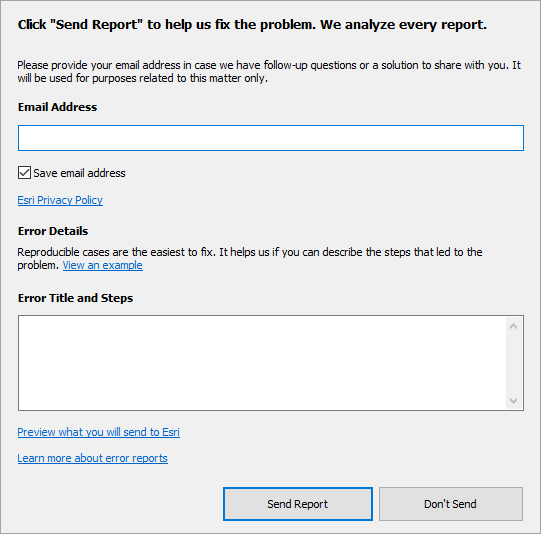It’s been a while, nearly four years in fact, since we raised awareness around the error reporting process behind ArcMap and ArcGIS Pro. What we shared at the time in this blog still holds true, and I’ll summarize it here so that you don’t feel tricked into having to read the prequel before you get to the heart of this new announcement:
- If you ever have to send in an error report as the result of a crash, we’re sorry.
- It is important to include your email address.
- It is helpful if you are able to provide details about what led up to the crash.
- We appreciate you submitting complete error reports since it helps to continually improve software stability.
So that’s the summary from four years ago that continues to hold true today. Now I want to focus specifically on point 2: It is important to include your email address.
You might be wondering, “Why is it so important for me to include my email address when submitting an error report?”
There are two reasons where having that email address can make a big difference – one of these reasons helps you directly and the other reason helps us (which ultimately still helps you and all users)!
The main reason that including a valid email address in the error report is a good thing for you to do is that if we have a high-confidence fix – meaning we know that this specific crash is fixed in a certain release or in a patch – there is an automated process that will send you an email letting you know where the fix is available.
Here’s a quote from a real user who gets it – it’s just that he was probably so frustrated that he couldn’t see straight to enter his email correctly. We understand – we’re sorry!
“Thanks Esri… it was several crashes yesterday… driving me potty… so much I failed to complete my email address properly! Thanks for the patch, I’ll try it and see how it goes.”
“Wait a tic, Kory. I feel like you’re back to playing tricks on us. If that user didn’t enter a valid email address, how is it that he responded to thank you, huh?” Great question! In this specific instance, I had noticed something bounce back, so I did some searching, found what I thought was likely the user’s correct email, and gave it a shot. BAM! We never heard back on this one, and that is almost always a good thing!
We want to continue to raise awareness around the process, because for the past 4-6 weeks we have been seeing a high number of crashes caused by a Microsoft .NET 4.8.x update. As users and organizations began rolling out the update, we saw a dramatic increase in a specific crash. This prompted us to investigate the issue and create a fix. The analytics showed us that the affected versions were ArcGIS Pro 2.8 and 2.9, so we responded by providing the fix in the 2.8.8 and 2.9.5 patches, respectively. Once the patches were available, as users sent error reports with an email address, they were automatically contacted, letting them know about the correct patch to install. However, we continue to receive error reports from users with no email address, and there is no way for us to reach out to let them know that the issue has already been fixed and they just need to apply the patch.

The second reason to include an email address is that it may help us fix the crash. Often, the information provided in the error report’s dump file (.dmp) is enough for a developer to confidently determine the cause of the failure and provide a fix. There is no need to have a reproducible case and no need to gather more information. Occasionally, however, we need additional information. A good way for us to get this information is to reach out to the individual who experienced the crash to see if they’re able to share more details, and the only way for us to do this is through a valid email address.
If we reach out to a user who recently experienced the crash and learn the steps that consistently cause the crash, it is highly likely that it can be fixed. The fix will often be included in a patch and made available to all users.
That’s what I wanted to share today. Please share this with your friends, colleagues, professional networks, and any other ArcGIS users who you think would benefit from understanding how the error reporting and outreach system works.
Banner photo by Mathyas Kurmann on Unsplash


Article Discussion: